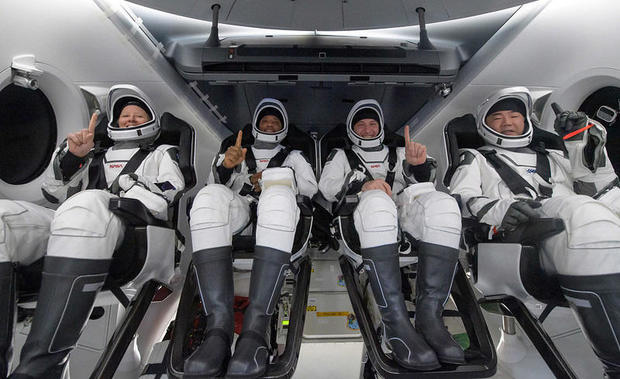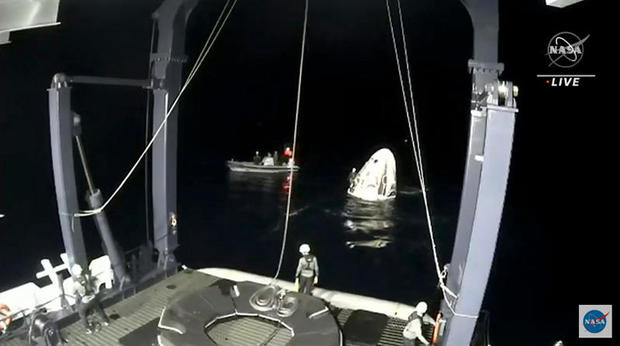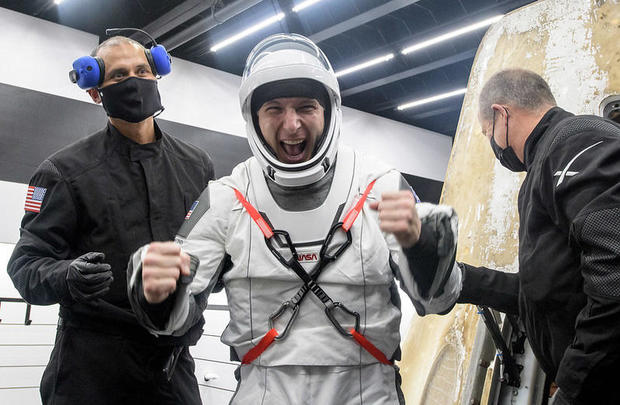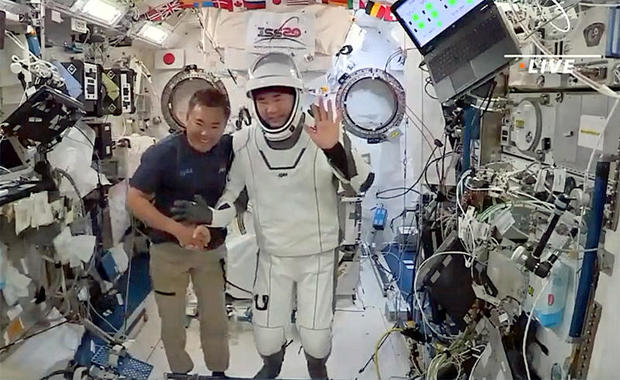Four astronauts strapped into their SpaceX Crew Dragon capsule, undocked from the International Space Station and plunged to a fiery pre-dawn splashdown in the Gulf of Mexico on Sunday, closing out the first operational flight of SpaceX's futuristic touch-screen ferry ship.
Crew-1 commander Michael Hopkins, along with NASA astronauts Victor Glover and Shannon Walker and Japanese astronaut Soichi Noguchi, disconnected from the space-facing port of the station's forward Harmony module at 8:35 p.m. EDT Saturday.
That set up only the second piloted water landing for NASA's post-shuttle commercial crew program and just the third night splashdown in space history — the first in nearly 45 years.
But the Crew Dragon executed a textbook return to Earth, dropping out of orbit, deploying four big parachutes and settling to a gentle splashdown south of Panama City, Florida, at 2:56 a.m., wrapping up a mission spanning 2,688 orbits over 168 days since launch last November.
"Dragon, on behalf of NASA and the SpaceX teams, we welcome you back to planet Earth, and thanks for flying SpaceX," the company's capsule communicator radioed. "For those of you enrolled in our frequent flyer program, you've earned 68 million miles on this voyage."
"It is good to be back on planet Earth," Hopkins replied. "And we'll take those miles. Are they transferable?"
"And Dragon, we'll have to refer you to our marketing department for that policy."
Despite the dead-of-night landing, NASA's WB-57 tracking aircraft captured spectacular infrared views of the capsule as it descended through the dense lower atmosphere while cameras aboard SpaceX's recovery ship showed the moment of splashdown.
SpaceX crews rushed to the Crew Dragon to secure the spacecraft and haul it on board a company recovery ship. The astronauts remained inside, waiting for the capsule to be hauled aboard where personnel were standing by to help them get out, on stretchers if needed, as they began re-adjusting to gravity after five and a half months in space.
"What a ride! Thanks to the @NASA, @SpaceX, and @USCG teams for a safe and successful journey back to Earth," Glover tweeted. "Another step closer to family and home!"
Before climbing out on his own, Hopkins radioed flight controllers at SpaceX headquarters in Hawthorne, California, saying "on behalf of Crew-1 and our families, we just want to say thank you."
"We want to say thank you for this amazing vehicle, Resilience," he said. "We said it before the mission and I'm going to say it again here afterward, It's amazing what can be accomplished when people come together. So finally, I'd just like to say, quite frankly, you all are changing the world. Congratulations. It's great to be back."
Following medical checks and phone calls home to friends and family, all four crew members were to be flown to shore by helicopter and handed off to NASA personnel for a flight back to the Johnson Space Center in Houston.
While mission managers prefer daylight landings, rough weather ruled out re-entry plans Wednesday and Saturday. With mild winds expected early Sunday, NASA and SpaceX agreed to target a pre-dawn return for the Crew-1 astronauts.
"Night landing? At Sea? Good thing there is a Naval Aviator on board! You got this "@AstroVicGlover!!!" tweeted astronaut Nick Hague, noting Glover's experience as a Navy F/A-18 carrier pilot. "Soft landings to the Crew of Resilience."
Unlike the first piloted Crew Dragon splashdown last August, when the spacecraft was quickly surrounded by boaters enjoying a sunny Sunday afternoon in the Gulf, the Coast Guard planned to enforce a 10-mile-wide safety zone for this landing to keep any early morning onlookers well away.
The Crew Dragon's return completed a record-pace crew rotation requiring two launches and two landings with four different spacecraft over just three weeks to replace the International Space Station's entire seven-member crew.
On April 9, a Russian Soyuz spacecraft carried Oleg Novitskiy, Pyotr Dubrov and NASA astronaut Mark Vande Hei to the station after a launch from the Baikonur Cosmodrome in Kazakhstan. They replaced another Soyuz crew — Sergey Ryzhikov, Sergey Kud-Sverchkov and Kate Rubins — who returned to Earth on April 17.
Then, on April 24, a Crew Dragon brought Crew-2 commander Shane Kimbrough, NASA astronaut Megan McArthur, European Space Agency astronaut Thomas Pesquet and Japanese flier Akihiko Hoshide to the station. The first stage of the Falcon 9 rocket that launched them the day before also helped launch Hopkins and company, the crew they are replacing aboard the station.
After helping the Crew-2 astronauts settle in aboard the lab complex, Hopkins, Glover, Walker and Noguchi, who arrived at the station on November 16, bid its seven crew members farewell Saturday evening and floated into their own Crew Dragon for undocking.
After moving a safe distance away, the ship's flight computer fired the ship's braking thrusters for about 16.5 minutes starting at 2:03 a.m. Sunday.
Moving through space at more than 17,100 mph — more than 83 football fields per second — the rocket firing slowed the Crew Dragon by 258 mph, just enough to drop the far side of the orbit into the dense lower atmosphere on a path targeting the Gulf of Mexico landing zone.
Protected by a high-tech heat shield, the Crew Dragon slammed into the discernible atmosphere around 2:45 a.m., rapidly decelerating in a blaze of atmospheric friction.
Once out of the plasma heating zone, the spacecraft's parachutes unfurled, allowing the ship to settle to a relatively gentle impact in the Gulf.
The most recent previous nighttime water landing came in October 1976 when two cosmonauts in a Soviet-era Soyuz spacecraft, making an unplanned descent in blizzard-like conditions after a failed docking, were blown off course into a large lake in Kazakhstan. It took recovery crews nine hours to move the spacecraft to shore and rescue the cosmonauts.
The only other night splashdown came in December 1968 when the crew of Apollo 8, coming home from a Christmas trip around the moon, carried out a planned, uneventful pre-dawn landing in the Pacific Ocean.
Article From & Read More ( SpaceX Crew Dragon astronauts arrive home with rare pre-dawn splashdown in Gulf of Mexico - CBS News )https://ift.tt/3ujqPC8
Science




No comments:
Post a Comment